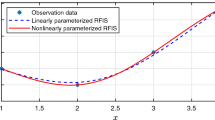Abstract
A LARS-based method is proposed for constructing a fuzzy regression model. Peculiarities of the use of fuzzy regression analysis for medical diagnosis are considered. The method allows one to reduce the number of parameters of the model that exert influence on the predictable degree of nasal obstruction and to avoid the risk of “overtraining” of the model.
Similar content being viewed by others
References
M. Dykewicz, S. Fineman, D. Skoner, R. Nicklas, R. Lee, J. Blessing-Moore, J. Li, I. Bernstein, W. Berger, S. Spector, and D. Schuller, “Diagnosis and management of rhinitis: Complete guidelines of the Joint Task Force on practice parameters in allergy, asthma and immunology,” Ann. Allergy Asthma Immunol., 81, 478–518 (1998).
P. Wheeler and S. Wheeler, “Vasomotor rhinitis,” Am. Fam. Physician, 72, No. 6, 1057–1062 (2005).
H. Dadgarnia, M. H. Baradaranfar, M. Mazidi, and M. R. Azimi, “Assessment of septoplasty effectiveness using acoustic rhinometry and rhinomanometry,” Iranian Journal of Otorhinolaryngology, 25, No. 71, 71–78 (2013).
H. L. Thulesius, A. Cervin, and M. Jessen, “Can we always trust rhinomanometry?” Rhinology, 49, No. 1, 46–52 (2011).
P. A. Clement and F. Gordts, “Standardization committee on objective assessment of the nasal airway: Consensus report on acoustic rhinometry and rhinomanometry,” Rhinology, 43, 169–179 (2005).
E. I. Canbay and S. N. Bhatia, “A comparison of nasal resistance in white, caucasians and blacks,” Rhinology, 11, Iss. 1, 73–75 (1997). doi:10.2500/105065897781446801.
B. K. Samolinski, A. Grzanka, and T. Gotlib, “Changes in nasal cavity dimensions in children and adults by gender and age,” Laryngoscope, 117, Iss. 8, 1429–1433 (2007). doi:10.1097/mlg.0b013e318064e837.
U. Crouse and M. T. Laine-Alava, “Effects of age, body mass index, and gender on nasal airflow rate and pressures,” Laryngoscope, 109, Iss. 9, 1503–1508 (1999). doi:10.1097/00005537-199909000-00027.
K. Vogt and A. A. Jalowayski, “4-Phase-rhinomanometry basics and practice,” Rhinology, 21, 1–50 (2010).
K. Naito, T. Mamiya, Y. Mishima, Y. Kondo, S. Miyata, and S. Iwata, “Comparison of calculated nasal resistance from Rohrer’s equation with measured resistance at delta P 150Pa,” Rhinology, 36, No. 1, 28–31 (1998).
F. Rührer, “Der Stromungswiderstand in der menschlichen Atemwegen,” Pflügers Arch Ges Physiology, 162, 225–295 (1915).
P. Broms, “Rhinomanometry. III. Procedures and criteria for distinction between skeletal stenosis and mucosal swelling,” Acta Otolaryngol., 94, 361–370 (1982).
G. Mlynski and A. Beule, “Diagnosis of respiratory function of the nose. Diagnostik der respiratorischen Funktion der Nase,” HNO, Springer Medizin Verlag, 56, Iss. 1, 81–99 (2008), http://link.springer.com/article/10.1007%2Fs00106-007-1655-0#page-2.
H. L. Thulesius, “Rhinomanometry in clinical use. A tool in the septoplasty decision making process,” Doctoral Dissertation, Clinical Sciences (2012).
L. Malm, R. G. Van Wijk, and C. Bachert, “Guidelines for nasal provocations with aspects on nasal patency, airflow, and airflow resistance,” International Committee on Objective Assessment of the Nasal Airways, International Rhinologic Society; Rhinology, 38, No. 1, 1–6 (2000), http://www.rhinologyjournal.com/abstract.php?id=88.
J. C. Juliá, Enriqueta M. Burchés, and A. Martorell, “Active anterior rhinomanometry in paediatrics. Normality criteria,” Allergologia et Immunopathologia, 39, No. 6, 342–346 (2011).
H. Tanaka, S. Uejima, and K. Asai, “Linear regression analysis with fuzzy model,” IEEE Transactions on Systems, Man and Cybernetics, 12, No. 6, 903–907 (1982).
P. Diamond, “Fuzzy least squares,” Information Sci., 46, No. 3, 141–157 (1988).
G. Peters, “Fuzzy linear regression with fuzzy intervals,” Fuzzy Sets and Systems, 63, No. 1, 45–55 (1994).
K. J. Kim, H. Moskowitz, and M. Koksalan, “Fuzzy versus statistical linear regression,” European Journal of Operational Research, 92, No. 2, 417–434 (1996).
V. Milea, R. J. Almeida, U. Kaymak, and F. Frasincar, “A fuzzy model of a European index based on automatically extracted content information,” in: Symposium on Computational Intelligence for Financial Engineering & Economics, IEEE Symposium (2011), pp. 1–8. doi: 10.1109/CIFER.2011.5953571.
K. Y. Chan, H. A. Lam, T. S. Dillon, and S. H. Ling, “A stepwise based fuzzy regression procedure for developing customer preference models in new product development,” Fuzzy Systems, IEEE Transactions on Fuzzy Systems, 23, Iss. 5 1–18 (2013).
A. S. Nechiporenko, “Technical aspects of rhinomanometry,” Eastern-European Journal of Enterprise Technologies, 4, No. 9(64), 11–14 (2013).
B. Efron, T. Hastie, I. Johnstone, and R. Tibshirani, “Least angle regression,” Ann. Statist., 32, No. 2, 407–499 (2004).
A. F. Shapiro, “Fuzzy regression models,” in: ARC USA (2005), pp. 1–17.
Author information
Authors and Affiliations
Corresponding author
Additional information
Translated from Kibernetika i Sistemnyi Analiz, No. 4, July–August, 2016, pp. 167–173.
Rights and permissions
About this article
Cite this article
Yerokhin, A.L., Babii, A.S., Nechyporenko, A.S. et al. A Lars-Based Method of the Construction of a Fuzzy Regression Model for the Selection of Significant Features. Cybern Syst Anal 52, 641–646 (2016). https://doi.org/10.1007/s10559-016-9867-5
Received:
Published:
Issue Date:
DOI: https://doi.org/10.1007/s10559-016-9867-5




